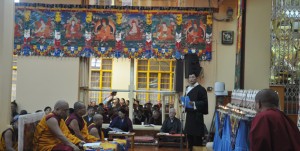The Tibetan Government-in-Exile, or Central Tibetan Administration (CTA), based in Dharamshala, completed its third year since transitioning into a democratic government on August 8. Over a thousand Tibetans attended a prayer service to celebrate the occasion.
During the ceremony, the Tibetan Prime Minister in Exile, Sikyong Lobsang Sangay, attributed the peaceful and successful transition to democracy, and trust in the new leadership, to the concerted effort and trust of the Tibetan people inside and outside Tibet. He also reasserted the CTA’s commitment to the Middle-Way Approach as a method to help Tibet overcome the problems it currently faces through the use of dialogue.
Despite the great democratic progress that has taken place in the Central Tibetan Administration, some Tibetans feel that it does not represent a proper democracy due to the lack of opposing political parties who could contest on differing policies. Jamyang Norbu, a Tibetan writer living in the US, has said “The administration…is not functioning that well at all. This is not a fully constituted democratic government-in-exile.” However, the views expressed in a forum in the Tibet Sun, suggest a strong wish to put unity of purpose and faith in the Dalai Lama over personal preference and insistence on Rangzen, or full independence, rather than the Middle-Way.
 “We need…an equal platform for Rangzen advocates to field their candidates against the…Middle-Way… healthy democracy is our best weapon”, says Tenzin Wangdue from Oregon, while Bhoepa says “This is entirely about Tibetans in Tibet. If the Middle-Way has failed, so has the Rangzen path … But at least there is a hope in Middle Way.”
“We need…an equal platform for Rangzen advocates to field their candidates against the…Middle-Way… healthy democracy is our best weapon”, says Tenzin Wangdue from Oregon, while Bhoepa says “This is entirely about Tibetans in Tibet. If the Middle-Way has failed, so has the Rangzen path … But at least there is a hope in Middle Way.”
“His Holiness is for Middle-Way and Tibetans in Tibet want to see/follow him. This clearly endorses his views – middle way. Many in exile have what they want. Now it’s the time to try to achieve what Tibetans in Tibet want” said Phuntsok Palden from Delhi, and Thondup Tsering, from the US added “Go follow your own path, for all our different paths must ultimately lead to a free Tibet!”
His Holiness the Dalai Lama moved from his semi-retirement position, as the head of government of the CTA, to complete retirement in 2011. Succeeding Kalon Tripa (the title was officially changed to Sikyong in 2012) Professor Samdhong Rinpoche, Sikyong Lobsang Sangay took over the foremost political seat in the CTA after he was elected in April 2011. He has called for young people to get involved in government: “To maintain unity and achieve effectiveness in the exile community, a central core is critical and for Tibetans, the CTA serves as this irreplaceable core. The Kashag [or Cabinet] invites dedicated youth to take leadership positions in the Central Tibetan Administration and in other Tibet-related organisations.”
 When the CTA was first established in 1959 by the Dalai Lama, His Holiness operated as head of state and head of government. The following years following saw a gradual democratic transition with the first parliamentary elections taking place in September 1980. In 2001, Professor Samdhong Rinpoche became the first democratically elected Prime Minister.
When the CTA was first established in 1959 by the Dalai Lama, His Holiness operated as head of state and head of government. The following years following saw a gradual democratic transition with the first parliamentary elections taking place in September 1980. In 2001, Professor Samdhong Rinpoche became the first democratically elected Prime Minister.
The CTA carries out its political authority under the “Charter of the Tibetans-in-Exile,” which was passed in July 1991. The Charter upholds democratic values and instills the separation of powers between the executive, judicial, and legislative branches of the CTA. The Judiciary branch of the CTA consists of the Tibetan Supreme Justice Commission. The Legislature is made of up the forty-four members of the Tibetan Parliament-in-Exile, while the executive branch houses the Sikyong and the Kashag, or Cabinet. The CTA’s Kashag presides over the departments of Home, Education, Finance, Security, Religion and Culture, Health, and Information and International Relations.





 Print
Print Email
Email